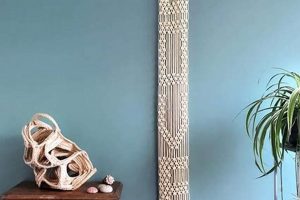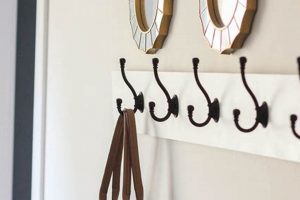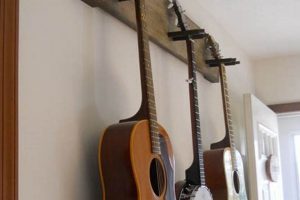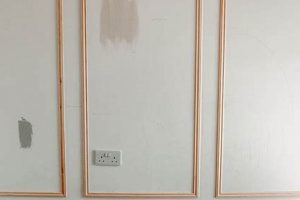The construction of decorative wall paneling through the use of vertically oriented wooden strips, achieved via do-it-yourself methods, represents a popular interior design trend. Such projects involve the precise cutting, preparation, and attachment of individual wooden pieces to a wall surface to create a visually appealing and textured aesthetic. Examples range from simple accent walls in residential spaces to more elaborate installations in commercial settings.
This approach to wall decoration offers several advantages. It enhances visual interest through the introduction of texture and depth, and allows for customization in material selection, spacing, and finish. Furthermore, this technique can contribute to improved acoustics within a room by diffusing sound waves. Historically, the utilization of wood paneling for decorative and functional purposes dates back centuries, with modern adaptations reflecting a renewed appreciation for natural materials and handcrafted elements in interior design.
The following sections will delve into essential aspects of successfully executing this kind of interior design project, including material selection, construction techniques, finishing options, and potential design variations.
Expert Guidance for Slat Wall Construction
The subsequent guidelines offer crucial advice for individuals embarking on a vertical wood slat wall project, ensuring a successful and aesthetically pleasing outcome. Adherence to these recommendations will mitigate common challenges and optimize the final appearance.
Tip 1: Precise Measurement and Planning: Prior to commencing any physical work, a detailed plan incorporating accurate measurements of the wall surface and slat dimensions is essential. This prevents material waste and ensures uniform slat spacing.
Tip 2: Optimal Wood Selection: The choice of wood impacts the project’s durability and aesthetic. Consider factors such as wood type (e.g., pine, oak, cedar), grain pattern, and resistance to moisture, particularly in humid environments.
Tip 3: Consistent Slat Preparation: Ensure that each slat is consistently cut, sanded, and, if desired, stained or painted before installation. Uniform preparation contributes to a professional and cohesive final appearance.
Tip 4: Secure and Level Installation: Employ a level and appropriate adhesive or fasteners to securely attach the slats to the wall. Uneven installation can detract significantly from the finished aesthetic.
Tip 5: Strategic Spacing Considerations: The spacing between slats influences the overall visual effect and can impact acoustics. Experiment with different spacing options to achieve the desired aesthetic and functional outcome.
Tip 6: Addressing Wall Imperfections: Prior to installation, address any imperfections in the wall surface, such as cracks or unevenness. A smooth and prepared wall ensures proper slat adhesion and a professional finish.
Tip 7: Finishing and Sealing: Apply a suitable sealant or finish to protect the wood from moisture, scratches, and UV damage. This extends the lifespan of the wall and preserves its appearance.
Adherence to these suggestions facilitates the creation of an impactful and enduring architectural feature. Through careful planning and execution, the project becomes a testament to craftsmanship and design acuity.
The following sections will explore considerations for long-term maintenance and creative embellishments to further enhance the installation.
1. Material Selection
Material selection is a foundational element in any “vertical wood slat wall diy” undertaking, directly influencing the final aesthetic, structural integrity, and longevity of the installation. The choice of wood species, its grade, and subsequent treatments directly affect the appearance and durability of the wall. For example, using cedar provides inherent resistance to moisture and decay, making it suitable for environments with fluctuating humidity. Conversely, pine, while more affordable, requires thorough sealing and protection to prevent warping or degradation. The quality of the wood, indicated by its grade (e.g., clear, select, common), determines the presence of knots and imperfections, impacting both the visual appeal and structural strength. The absence of careful material selection can lead to premature failure or an aesthetically compromised result.
Beyond the species and grade of wood, the method of preparing the material contributes significantly. Kiln-dried wood is less prone to warping and shrinking compared to air-dried lumber. The dimensions of the slats, including their thickness and width, must be consistently maintained for a uniform appearance. Surface treatments, such as staining or painting, necessitate the selection of appropriate products compatible with the chosen wood type. Consider a scenario where an incompatible stain is applied to a dense hardwood; the stain may not properly penetrate, resulting in an uneven finish. Furthermore, the selection of appropriate fasteners or adhesives is critical to ensure secure and lasting attachment of the slats to the wall surface. Inappropriate fasteners can cause splitting or damage to the wood, compromising the structural integrity.
In conclusion, careful deliberation regarding material selection is paramount to the success of any “vertical wood slat wall diy” project. A thorough understanding of the properties and limitations of different wood species, grades, and treatments, coupled with attention to preparation techniques and fastener selection, is essential for achieving a durable, visually appealing, and long-lasting architectural feature. The initial investment in appropriate materials and preparation translates directly into a reduction in future maintenance costs and an enhancement of the project’s overall value.
2. Accurate Measurements
The precision of dimensional data is paramount in the execution of a successful “vertical wood slat wall diy” project. Without accurate measurements, the resulting installation risks misalignment, material wastage, and an aesthetically compromised final product. The following outlines key areas where precise measurements are critical.
- Wall Surface Dimensions
Precise measurement of the wall’s height and width is the fundamental starting point. Inaccurate data leads to miscalculation of the number of slats required, potentially resulting in insufficient materials or excessive waste. Real-world examples include walls that are not perfectly square, requiring adjustments in slat length to maintain visual alignment. Failure to account for such irregularities results in visible gaps or uneven slat terminations.
- Slat Dimensions and Quantity
Measurements of individual slat width and thickness are crucial for uniform spacing and a consistent appearance. Even slight variations in slat dimensions, when multiplied across an entire wall, can lead to noticeable discrepancies in the overall pattern. An example of this is when using reclaimed wood; each slat must be measured individually to ensure uniformity after cutting.
- Spacing Calculations
The accurate calculation of spacing between slats is essential for achieving the desired visual effect. This involves determining the optimal gap size based on the slat width and the overall wall dimensions. Incorrect spacing calculations can result in a wall that appears either too dense or too sparse, altering the intended aesthetic. For example, a design intended to create a light, airy feel would be compromised by too narrow a spacing, leading to a more enclosed and heavy appearance.
- Level and Plumb Lines
Establishing accurate level and plumb lines is vital for ensuring that the slats are installed vertically and uniformly. Deviation from true verticality results in a visually skewed appearance, detracting from the overall professionalism of the installation. The use of laser levels and plumb bobs are recommended to establish these lines with precision. For instance, using a spirit level on a slightly uneven floor can introduce errors that accumulate over the height of the wall, leading to a noticeable slant.
In summation, the success of any “vertical wood slat wall diy” endeavor hinges on the precision of measurements throughout the planning and execution phases. These measurements directly impact material usage, aesthetic consistency, and the overall structural integrity of the finished product. Without meticulous attention to detail in this aspect, the resulting installation is likely to fall short of its intended design and quality standards.
3. Slat Preparation
Slat preparation is a critical phase in the execution of a “vertical wood slat wall diy” project, directly influencing the aesthetic outcome, durability, and ease of installation. Thorough preparation mitigates potential issues during the construction phase and ensures a professional finished product.
- Dimensional Accuracy and Consistency
Slat preparation begins with precise cutting to specified dimensions. Dimensional inconsistencies among slats result in uneven spacing, misalignment, and a visually fragmented appearance. For instance, variations as small as 1/16th of an inch can accumulate across multiple slats, leading to noticeable discrepancies. Ensuring dimensional accuracy requires the use of precision cutting tools, such as table saws with accurate fences and miter saws with calibrated angles.
- Surface Finishing Techniques
Surface finishing encompasses sanding, staining, and sealing of the wood. Sanding removes imperfections, smooths the surface, and prepares the wood to accept finishes uniformly. Staining enhances the natural grain and provides color customization. Sealing protects the wood from moisture, UV damage, and wear. A failure to properly sand can result in an uneven stain absorption, leading to blotchy appearance. Improper sealing leaves the wood vulnerable to environmental damage, reducing the lifespan of the wall.
- Edge Treatment and Profiling
Edge treatment involves shaping and finishing the edges of each slat. This can include rounding the edges to prevent sharp corners, creating a bevel for aesthetic purposes, or applying a sealant to protect the end grain. Untreated edges are prone to splintering and moisture absorption, potentially leading to warping or decay. Careful edge treatment contributes to the overall refined appearance of the wall.
- Pre-Drilling and Hardware Preparation
Pre-drilling pilot holes for fasteners is essential to prevent splitting during installation, particularly with hardwoods. The appropriate size of the pilot hole depends on the type and diameter of the fastener being used. Hardware preparation may also include countersinking holes to allow for flush mounting of screws. Failing to pre-drill can result in damaged slats and a compromised structural integrity.
In summary, the quality and thoroughness of slat preparation directly correlate with the overall success of a “vertical wood slat wall diy” project. Consistent and meticulous attention to dimensional accuracy, surface finishing, edge treatment, and hardware preparation contributes to a visually appealing, durable, and professionally executed architectural feature. Overlooking these preparatory steps often results in avoidable complications and a diminished final product.
4. Secure Installation
Secure installation constitutes a fundamental requirement for the successful implementation and longevity of a “vertical wood slat wall diy” project. Proper attachment methods ensure the structural integrity of the wall, prevent potential hazards, and maintain the desired aesthetic over time. This discussion will explore critical facets of secure installation within this context.
- Adhesive Selection and Application
The selection of an appropriate adhesive is crucial for bonding the wood slats to the substrate wall. The adhesive must be compatible with both the wood species and the wall material (e.g., drywall, concrete). Improper adhesive selection can lead to detachment, instability, and eventual failure of the installation. For example, using a water-based adhesive on a non-porous surface may result in poor adhesion and subsequent slat delamination. Furthermore, proper application techniques, including adequate coverage and appropriate curing times, are essential for maximizing adhesive performance.
- Fastener Selection and Placement
When employing mechanical fasteners, such as nails or screws, the choice of fastener type and size must align with the slat thickness, wall material, and anticipated load. Improper fastener selection can result in splitting of the wood or inadequate anchoring in the wall. Example scenarios include using excessively long screws that protrude through the back of the wall or employing insufficient fasteners that cannot adequately support the weight of the slats. Precise placement of fasteners, typically along pre-determined lines, ensures uniform distribution of stress and prevents localized points of weakness.
- Substrate Preparation and Compatibility
Prior to installation, the wall substrate must be properly prepared to ensure optimal adhesion and fastener engagement. This may involve cleaning the surface to remove dust, debris, and loose paint; leveling uneven areas to provide a smooth bonding surface; and applying a primer to enhance adhesion. Incompatible substrates, such as glossy paint or loose wallpaper, can significantly reduce the effectiveness of adhesives and fasteners. Failure to adequately prepare the substrate can compromise the entire installation, leading to premature failure and potential safety hazards.
- Addressing Structural Considerations
In certain instances, the design of a “vertical wood slat wall diy” project may necessitate structural reinforcement, particularly if the wall is load-bearing or if the slats are exceptionally heavy. This can involve attaching the slats directly to wall studs for increased stability or incorporating additional support elements, such as horizontal bracing. Neglecting structural considerations can lead to bowing, sagging, or even collapse of the wall, posing significant safety risks. Proper assessment of the wall’s structural capacity and implementation of appropriate reinforcement measures are paramount for ensuring the long-term stability and safety of the installation.
In conclusion, the secure installation of a “vertical wood slat wall diy” project is not merely a matter of aesthetic execution; it is a fundamental prerequisite for ensuring the structural integrity, safety, and longevity of the installation. Careful attention to adhesive selection, fastener placement, substrate preparation, and structural considerations is essential for achieving a successful and durable result. Compromising on any of these aspects can lead to significant problems down the line, underscoring the importance of prioritizing secure installation practices throughout the entire process.
5. Design Variations
Design variations constitute a critical component of the “vertical wood slat wall diy” process, influencing the aesthetic impact, functionality, and personalization of the finished product. The inherent modularity of slat wall construction lends itself to a multitude of customizable options, allowing for significant design flexibility. The choices made regarding slat dimensions, spacing, orientation, and materials directly affect the overall visual impression and can be tailored to complement diverse architectural styles and interior design preferences. For example, employing wider slats with minimal spacing creates a bold, modern aesthetic, while narrower slats with increased spacing evoke a more traditional or minimalist sensibility. The selection of wood species and finishes further contributes to the overall design, allowing for seamless integration with existing dcor or the creation of a distinctive focal point within a space. Without careful consideration of design variations, the resulting wall may lack visual appeal or fail to meet the specific functional requirements of the environment.
Beyond purely aesthetic considerations, design variations offer opportunities to enhance the functionality of a slat wall installation. Incorporating integrated lighting elements, such as recessed LED strips, can create ambient illumination or highlight specific architectural features. Varying the depth of the slats can introduce a three-dimensional texture and improve acoustic performance by diffusing sound waves. Strategically placed gaps or openings can accommodate shelving, artwork, or other decorative elements, transforming the wall into an integrated storage and display system. A real-world example includes the integration of vertical planters within a slat wall to create a living green wall, enhancing both the aesthetic and environmental qualities of the space. Furthermore, design variations can address specific challenges related to room geometry or existing architectural constraints, allowing for customized solutions that optimize the use of available space.
In conclusion, the deliberate exploration and implementation of design variations are essential for maximizing the potential of a “vertical wood slat wall diy” project. These variations extend beyond mere cosmetic adjustments, offering opportunities to enhance functionality, personalize the design, and address specific architectural challenges. The thoughtful integration of design variations transforms a basic wall treatment into a dynamic and impactful architectural feature, reflecting the individual style and needs of the user. Ignoring these opportunities can result in a missed chance to create a truly unique and functional element within the built environment.
Frequently Asked Questions
This section addresses common inquiries and misconceptions regarding the construction and installation of vertical wood slat walls using do-it-yourself methods. The information presented aims to provide clarity and assist in informed decision-making.
Question 1: What is the typical cost associated with a vertical wood slat wall DIY project?
The cost is influenced by several factors, including the type of wood selected, the wall size, the complexity of the design, and any required tools or materials not already possessed. Hardwoods, such as oak or walnut, command higher prices than softwoods like pine. Larger walls require more materials, increasing the overall expense. Intricate designs involving angled cuts or integrated lighting add to the labor and material costs.
Question 2: How challenging is it to construct a vertical wood slat wall as a DIY project for someone with limited experience?
The difficulty level varies depending on the complexity of the design and the individual’s woodworking skills. Simple designs involving straight cuts and uniform spacing are generally manageable for beginners. However, more complex patterns or installations requiring precise measurements and intricate joinery demand greater skill and experience. Access to appropriate tools and a clear understanding of basic woodworking techniques are essential for successful completion.
Question 3: What types of wood are most suitable for vertical wood slat wall construction?
The optimal wood choice depends on factors such as desired aesthetic, budget, and environmental conditions. Hardwoods offer greater durability and resistance to wear, while softwoods are more affordable and easier to work with. Cedar is a suitable option for environments with high humidity due to its natural resistance to moisture. Reclaimed wood provides a unique aesthetic but may require additional preparation and treatment.
Question 4: Is it necessary to apply a finish to a vertical wood slat wall, and if so, what type is recommended?
Applying a finish is generally recommended to protect the wood from moisture, UV damage, and wear, extending the lifespan and preserving the aesthetic appearance. The type of finish depends on the desired look and level of protection. Polyurethane provides a durable, water-resistant finish suitable for high-traffic areas. Oil-based finishes enhance the natural grain and offer a warm, traditional appearance. Water-based finishes are low-VOC and environmentally friendly.
Question 5: How can sound absorption be improved when building a vertical wood slat wall?
Sound absorption can be enhanced by increasing the spacing between the slats and incorporating sound-absorbing materials behind the wall. The gaps between the slats allow sound waves to pass through, and the backing material absorbs the sound energy. Materials such as acoustic panels, mineral wool insulation, or specialized acoustic foams are effective at reducing sound reflections and reverberation within a room.
Question 6: What are the potential challenges or pitfalls to avoid when undertaking a vertical wood slat wall DIY project?
Common challenges include inaccurate measurements, inconsistent slat spacing, improper adhesive or fastener selection, and inadequate substrate preparation. These issues can lead to misalignment, instability, and a compromised aesthetic. It is crucial to carefully plan the project, double-check measurements, and ensure compatibility between materials and techniques to avoid these pitfalls.
In summary, careful planning, material selection, and execution are paramount to a successful project. Addressing these frequently asked questions will help navigate the process more effectively.
The following section will discuss maintenance and long-term care considerations.
Conclusion
The preceding sections have detailed crucial aspects of vertical wood slat wall DIY endeavors. Topics covered include material selection’s impact on aesthetics and durability, the necessity of accurate measurements for visual harmony, the importance of thorough slat preparation for long-term stability, the need for secure installation methods to ensure structural integrity, and the expansive possibilities offered by design variations for customization. The successful completion of such a project hinges on careful consideration and execution of each of these elements.
The integration of vertical wood slat walls represents a significant design choice with long-term implications. Therefore, a thorough understanding of the principles outlined herein is paramount. Those undertaking such projects are encouraged to proceed with diligence, prioritizing both aesthetic appeal and structural soundness to realize a lasting and visually compelling architectural feature.







